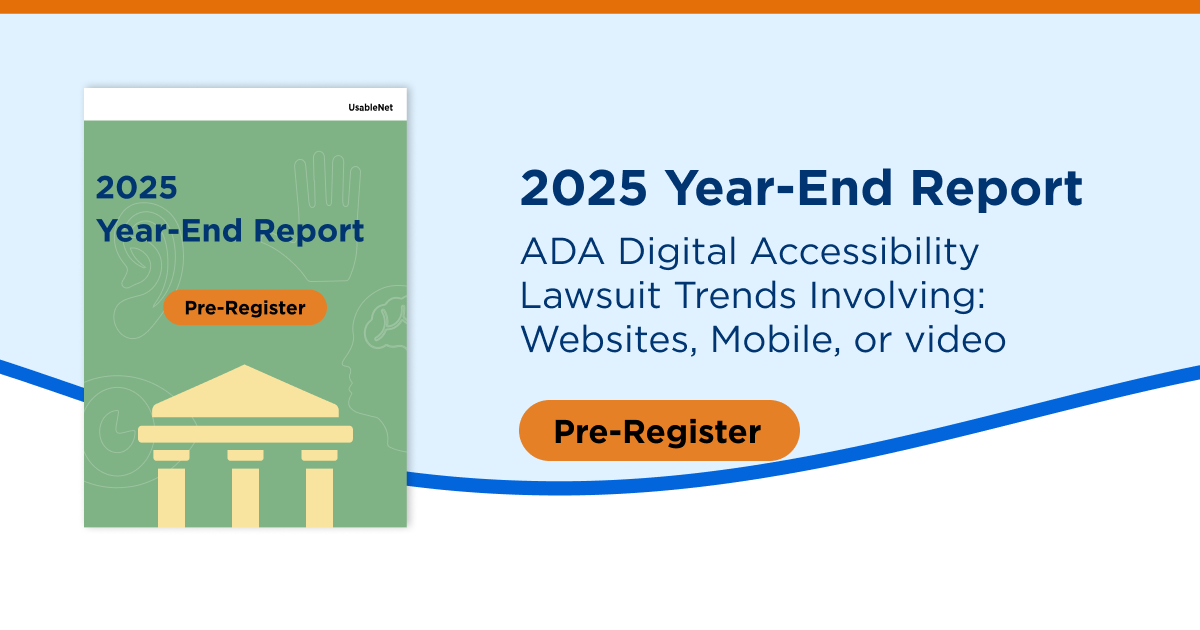For the sixth consecutive year, UsableNet has compiled its ADA Web and App Lawsuit Report, comprehensively analyzing trends in digital accessibility lawsuits. This year’s report is based on rigorous tracking of lawsuits filed under the ADA at federal and state levels.
The UsableNet research team tracks and documents all digital accessibility lawsuits involving websites, mobile apps, and video content. This report covers all cases filed across the 11 federal circuit courts under the ADA, plus cases filled in key individual state courts, including New York and California, highlighting the latest trends as of December 2024. This process enables UsableNet to provide our clients with the most current advice for planning digital accessibility initiatives.
Download the report for free here.
As businesses navigate ADA-related risks, it's also crucial to prepare for the European Accessibility Act (EAA), which will begin enforcement in June 2025. Companies serving customers in the EU must comply with these new regulations. Learn more in our EAA compliance guide.
Key Highlights from 2024
Federal Decline, State Rise

In 2024, over 4,000 ADA lawsuits related to digital properties were filed. Federal cases saw a slight decline, offset by increased state-level lawsuits, particularly in New York and California.
What’s behind the shift?
- Plaintiffs and firms are leveraging state-specific laws more frequently.
- Plaintiffs may see certain state courts as more favorable for digital accessibility claims.
Key Insight:
This trend is likely to continue, making state-level compliance a critical focus for businesses operating in these jurisdictions.
With accessibility laws evolving, companies operating internationally should also be aware of upcoming European regulations. Our EAA On-Demand Webinar outlines key requirements and steps for businesses to prepare.
Repeat Lawsuits Highlight Ongoing Risk

One in four lawsuits filed in 2024 involved companies that plaintiffs had already sued in the past. Companies received 961 repeat lawsuits, representing over 40% of all cases.
Why are repeat lawsuits so common?
- Multiple Properties: Companies with multiple websites or brands risk claims with each non-compliant site.
- Visibility: A previous lawsuit often draws attention to unresolved accessibility issues, making companies easier targets.
- No Legal Protection: A lawsuit doesn’t shield businesses from new claims for the same accessibility barriers.
Key Insight:
Swift and comprehensive remediation after an initial claim is essential. Proactive compliance reduces the risk of repeat litigation.
New York Leads ADA Lawsuit Activity

New York remains the most active jurisdiction for ADA digital lawsuits at the federal and state levels.
Why New York?
- Courts are more open to hearing cases involving websites without physical locations.
- Many plaintiff law firms have offices in the state.
- Companies conducting business in New York are vulnerable to litigation, regardless of their headquarters location.
Key Insight:
If your business serves customers in New York, you'll want to ensure your digital properties conform with WCAG 2.2 standards to reduce legal risk.
E-commerce Faces the Most Pressure

E-commerce websites were the primary targets of ADA lawsuits in 2024.
Why e-commerce?
- Frequent Updates: Constantly changing features can introduce new accessibility barriers.
- Physical Nexus: Many e-commerce sites have physical stores, which increases their legal exposure.
- Ease of Claims: Plaintiffs can easily demonstrate accessibility issues during shopping.
Key Insight:
E-commerce businesses must treat accessibility as a priority to reduce litigation risk and enhance customer experience.
Widgets Continue to Fail as a Solution

In 2024, over 1,000 businesses were sued despite having accessibility widgets on their websites, accounting for more than 25% of cases.
What’s the issue with widgets?
- Widgets don’t address underlying accessibility barriers.
- They fail to provide legal protection or long-term solutions.
Key Insight:
Accessibility requires a strategic, ongoing effort—not a quick fix. Investing in sustainable improvements leads to better outcomes for businesses and users alike.
Download your copy of the End of Year Report on Digital Accessibility Lawsuits now!
Conclusion
The 2024 Year-End ADA Web and App Lawsuit Report highlights significant insights for companies to consider in 2025, including the rise in state-level lawsuits and the growing risks for companies that fail to address accessibility comprehensively.
For international organizations, preparing for the European Accessibility Act (EAA) is just as crucial as meeting ADA requirements.
Our 2025 End-of-Year Report on Digital Accessibility Lawsuits will be out soon. Preregister now and be among the first to access the report!










